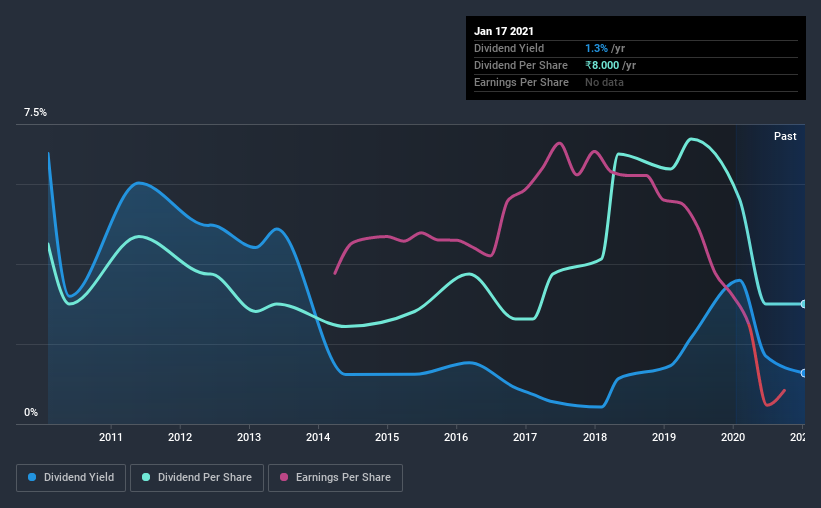- India
- /
- Auto Components
- /
- NSEI:RANEHOLDIN
Factors Income Investors Should Consider Before Adding Rane Holdings Limited (NSE:RANEHOLDIN) To Their Portfolio

Dividend paying stocks like Rane Holdings Limited (NSE:RANEHOLDIN) tend to be popular with investors, and for good reason - some research suggests a significant amount of all stock market returns come from reinvested dividends. Yet sometimes, investors buy a stock for its dividend and lose money because the share price falls by more than they earned in dividend payments.
A slim 1.3% yield is hard to get excited about, but the long payment history is respectable. At the right price, or with strong growth opportunities, Rane Holdings could have potential. That said, the recent jump in the share price will make Rane Holdings's dividend yield look smaller, even though the company prospects could be improving. Some simple research can reduce the risk of buying Rane Holdings for its dividend - read on to learn more.
Explore this interactive chart for our latest analysis on Rane Holdings!

Payout ratios
Dividends are usually paid out of company earnings. If a company is paying more than it earns, then the dividend might become unsustainable - hardly an ideal situation. Comparing dividend payments to a company's net profit after tax is a simple way of reality-checking whether a dividend is sustainable. Although it reported a loss over the past 12 months, Rane Holdings currently pays a dividend. When a company is loss-making, we next need to check to see if its cash flows can support the dividend.
Rane Holdings paid out 127% of its free cash flow last year, which we think is concerning if cash flows do not improve.
Remember, you can always get a snapshot of Rane Holdings' latest financial position, by checking our visualisation of its financial health.
Dividend Volatility
One of the major risks of relying on dividend income, is the potential for a company to struggle financially and cut its dividend. Not only is your income cut, but the value of your investment declines as well - nasty. Rane Holdings has been paying dividends for a long time, but for the purpose of this analysis, we only examine the past 10 years of payments. This dividend has been unstable, which we define as having been cut one or more times over this time. During the past 10-year period, the first annual payment was ₹12.0 in 2011, compared to ₹8.0 last year. The dividend has shrunk at around 4.0% a year during that period. Rane Holdings' dividend has been cut sharply at least once, so it hasn't fallen by 4.0% every year, but this is a decent approximation of the long term change.
When a company's per-share dividend falls we question if this reflects poorly on either external business conditions, or the company's capital allocation decisions. Either way, we find it hard to get excited about a company with a declining dividend.
Dividend Growth Potential
With a relatively unstable dividend, it's even more important to evaluate if earnings per share (EPS) are growing - it's not worth taking the risk on a dividend getting cut, unless you might be rewarded with larger dividends in future. Over the past five years, it looks as though Rane Holdings' EPS have declined at around 24% a year. A sharp decline in earnings per share is not great from from a dividend perspective, as even conservative payout ratios can come under pressure if earnings fall far enough.
Conclusion
Dividend investors should always want to know if a) a company's dividends are affordable, b) if there is a track record of consistent payments, and c) if the dividend is capable of growing. We're a bit uncomfortable with Rane Holdings paying a dividend while loss-making, especially since the dividend was also not well covered by free cash flow. Earnings per share are down, and Rane Holdings' dividend has been cut at least once in the past, which is disappointing. In this analysis, Rane Holdings doesn't shape up too well as a dividend stock. We'd find it hard to look past the flaws, and would not be inclined to think of it as a reliable dividend-payer.
Investors generally tend to favour companies with a consistent, stable dividend policy as opposed to those operating an irregular one. Meanwhile, despite the importance of dividend payments, they are not the only factors our readers should know when assessing a company. Case in point: We've spotted 4 warning signs for Rane Holdings (of which 1 is significant!) you should know about.
Looking for more high-yielding dividend ideas? Try our curated list of dividend stocks with a yield above 3%.
If you decide to trade Rane Holdings, use the lowest-cost* platform that is rated #1 Overall by Barron’s, Interactive Brokers. Trade stocks, options, futures, forex, bonds and funds on 135 markets, all from a single integrated account. Promoted
New: AI Stock Screener & Alerts
Our new AI Stock Screener scans the market every day to uncover opportunities.
• Dividend Powerhouses (3%+ Yield)
• Undervalued Small Caps with Insider Buying
• High growth Tech and AI Companies
Or build your own from over 50 metrics.
This article by Simply Wall St is general in nature. It does not constitute a recommendation to buy or sell any stock, and does not take account of your objectives, or your financial situation. We aim to bring you long-term focused analysis driven by fundamental data. Note that our analysis may not factor in the latest price-sensitive company announcements or qualitative material. Simply Wall St has no position in any stocks mentioned.
*Interactive Brokers Rated Lowest Cost Broker by StockBrokers.com Annual Online Review 2020
Have feedback on this article? Concerned about the content? Get in touch with us directly. Alternatively, email editorial-team (at) simplywallst.com.
About NSEI:RANEHOLDIN
Rane Holdings
Manufactures and markets automotive components for the transportation industry in India and internationally.
Established dividend payer and good value.
Similar Companies
Market Insights
Community Narratives




